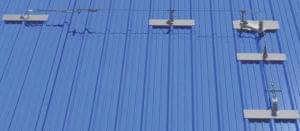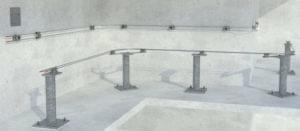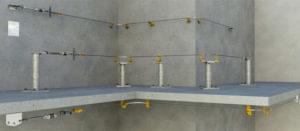OSHA makes it clear that roof safety is non-negotiable: "Each employee on a walking/working surface (horizontal and vertical surface) with an unprotected side or edge which is 6 feet (1.8 m) or more above a lower level shall be protected from falling by the use of guardrail systems, safety net systems, or personal fall arrest systems." However, how you protect workers from falling can vary depending on the circumstances. Roof lifeline systems are one of your fall protection options.
You may know you need roof lifelines, but there are several to choose from, including temporary and permanent lifelines. How do you know which one is right for your work site?
Each worksite is unique and may require different roof safety measures. Even among horizontal lifeline systems alone, you have options about where to install the system and how to configure it on the job site. When making your choices, ask yourself these questions:
Some jobs are short-term. Window washing, aircraft maintenance, and roof repairs or inspection are occasional occurrences that may not require (or in some cases do not allow) permanent lifelines to be in place, and a temporary lifeline may be used in these cases.
Installing permanent lifelines is ideal for ongoing work. When your employees regularly need to access a job site or are working on a long-term construction project, these lifelines can be installed once and protect your team for the duration. If a fall does occur, you can often replace the affected components rather than the entire system.
You can choose the right horizontal lifeline systems based on how many workers need to use it, where the lifeline can be anchored, and how much space your workers need to cover. Some systems are made to protect workers on ladders and other vertical structures, while others are appropriate for rooftops, bridges, and more. You can choose a system that easily allows workers to move past one another safely and efficiently to gain access to all areas of the roof.
In all cases, it's essential to choose OSHA-compliant equipment and consult with an expert about how to best configure your horizontal lifeline systems. These devices should also be professionally installed to ensure safety.
Like lifelines, anchor points can be permanent or temporary. These are perfect when you have one worker on the site and the anchor can be positioned to allow that person to access everything he or she needs. With anchor points, you are limited to a radius around that point. If you have multiple workers, you would have to install numerous anchors, which can be difficult in terms of positioning and consideration for how your workers need to move.
Horizontal lifelines give multiple workers more freedom. They can be installed down the middle of your work space or around the perimeter; you can choose a lifeline that can be installed on the floor, ceiling, or wall according to your needs. OSHA-compliant systems and professional installation are necessary to ensure these roof lifeline systems are strong enough to withstand the forces they would experience if someone were to fall.
Here are a few permanent lifelines and their applications:
 Permanent Single-Cable Horizontal Lifeline System for Light Structures: Great for lightweight structures with flat or sloped roofs, this system requires no special tools for installation. It's good for up to three users for building maintenance, inspection, or repair.
Permanent Single-Cable Horizontal Lifeline System for Light Structures: Great for lightweight structures with flat or sloped roofs, this system requires no special tools for installation. It's good for up to three users for building maintenance, inspection, or repair.
 Permanent Twin Wire Rope Horizontal Lifeline System: Good for up to five users, this can be anchored to the ceiling, wall, or floor. There's no limit to the length of this system, making it great for bridges, viaducts, industrial plants, aircraft hangers, building maintenance, and more.
Permanent Twin Wire Rope Horizontal Lifeline System: Good for up to five users, this can be anchored to the ceiling, wall, or floor. There's no limit to the length of this system, making it great for bridges, viaducts, industrial plants, aircraft hangers, building maintenance, and more.
 Permanent Single-Cable Horizontal Lifeline System: This is a versatile system for up to five users. It can be installed to the floor, ceiling, wall, posts, or under an inclined surface. These need to be designed by engineers but can be installed by anyone. Again, it can be used on a wide range of construction and maintenance sites.
Permanent Single-Cable Horizontal Lifeline System: This is a versatile system for up to five users. It can be installed to the floor, ceiling, wall, posts, or under an inclined surface. These need to be designed by engineers but can be installed by anyone. Again, it can be used on a wide range of construction and maintenance sites.Roof lifeline systems are just one line of defense when it comes to worker safety. Utilizing other safety devices like guardrails and safety gates around roof holes, skylights and uneven levels should also be a part of your roof safety plan. And all your systems should be inspected regularly for signs of wear and tear. A system that is exposed to rain, freezing and thawing, direct sunlight, and other extreme conditions may need to be replaced more often. All employees should be thoroughly trained in the use of all systems you use, and they should be encouraged to report damages—even if that means a delay in the workday. The harnesses and lanyards used with your lifeline also need to be inspected before each use, and employees should work together to help each other ensure they are properly fitted before beginning work.
Roof safety goes beyond equipment. It's an attitude, both for employees and employers. Building a culture of safety includes using the right equipment, giving employees proper training, considering weather conditions and other variables, and the willingness to put safety first, even at the expense of a deadline. Nothing's more important on the roof than making sure everyone can do their job safely.
For more information about roof safety and fall arrest systems, please contact us. All of our products are designed to meet or exceed OSHA regulations, and we can help you determine which systems are best for your unique job site.